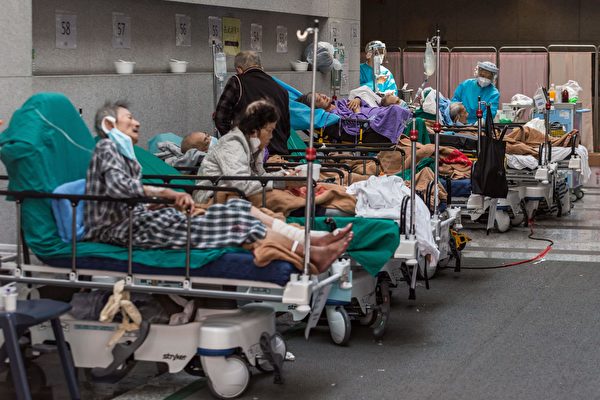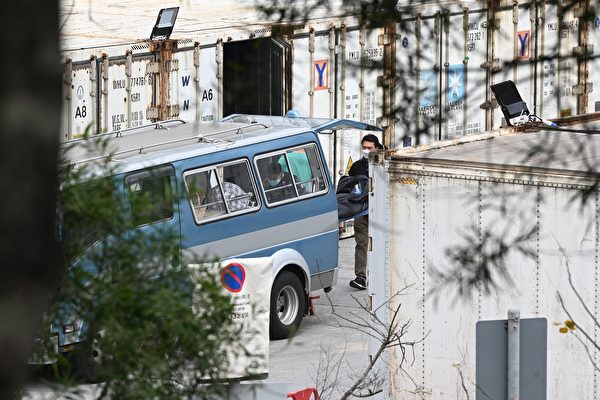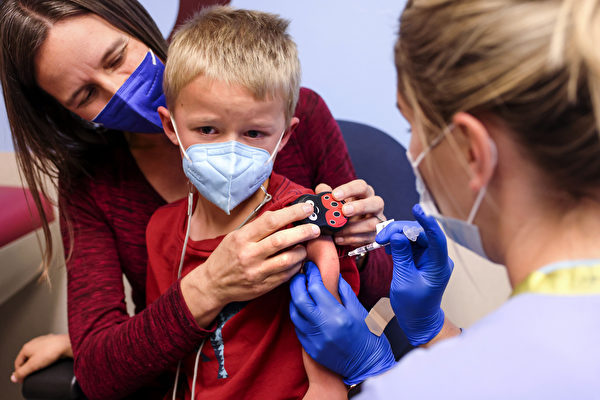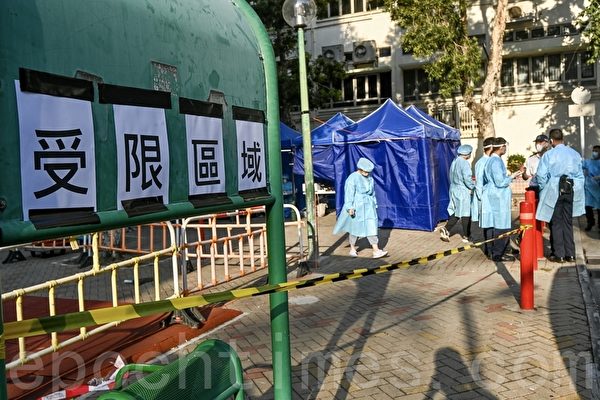[The Epoch Times, March 15, 2022](The Epoch Times reporter Daphra comprehensive report) According to statistics from Johns Hopkins University, as of 4:20 p.m. Eastern Time on Tuesday (March 15), the global CCP The total number of virus (Wuhan pneumonia, coronavirus, COVID-19) cases exceeded 460 million (460,680,236) and the death toll exceeded 6.04 million (6,049,013).
The following are the statistics of the number of new confirmed cases and deaths in a single day in some countries on Monday (March 14) (some data are adjusted according to worldometers):
17,267 confirmed cases in the United States and 326 deaths;
3,201 confirmed cases in Canada, 52 deaths;
Australia has 26,418 confirmed cases and 5 deaths;
47,181 confirmed cases in the UK, 45 deaths;
France has 18,853 confirmed cases and 185 deaths;
Germany has 101,872 confirmed cases and 136 deaths;
Russia has 41,055 confirmed cases and 533 deaths;
Brazil has 13,420 confirmed cases and 187 deaths;
India has 2,568 confirmed cases and 98 deaths;
52,002 confirmed cases in Japan and 125 deaths;
South Korea has 309,769 confirmed cases and 200 deaths;
75 confirmed cases in Taiwan, 0 deaths;
Hong Kong has 26,908 confirmed cases and 286 deaths.
Here are real-time updates on the CCP virus outbreak:
Hong Kong Fangcai: Helpless crying outside mother-in-law’s room
After being sent to a temporary isolation center (commonly known as a “fangcang shelter hospital”) for isolation, a diabetic mother-in-law in Hong Kong sat outside her room crying because she felt helpless.
The Hong Kong Economic Times reported that since the official opening of the Tsing Yi Community Isolation Facility (also known as the “fangcang shelter hospital”), the Hong Kong government has successively sent infected patients with no symptoms or mild symptoms to stay. Recently, some people admitted to the Fangcang cabin hospital found that a mother-in-law with diabetes was helpless and crying outside the room after being sent to the camp alone.
Zhang Maoqing, a former member of the Hong Kong parliament, posted on his social media yesterday (March 13) that a neighbor who was admitted to the makeshift hospital shared his internal situation and mentioned the above case. The neighbor said that at 8 o’clock in the evening, he saw a mother-in-law sitting alone outside the room crying.
Neighbors therefore went to talk to her mother-in-law, got to know her, handed her a tissue, and comforted her.
It turns out that my mother-in-law suffers from diabetes and usually needs injections. Recently, she was sent to the camp due to the forced inspection of the building enclosure.
The neighbor indicated that he would help his mother-in-law and reassure her. After talking, the mother-in-law finally felt at ease and went back to sleep.
Neighbors said that the mother-in-law was only one of the cases, and another woman was also overwhelmed. She didn’t know the destination before getting on the shuttle bus, and she could not choose to go to the isolation camp or hotel, perhaps because of the large number of confirmed cases.
Zhang Maoqing, a former district councillor, pointed out that after the Fangcang shelter hospital is completed, management issues still need to be dealt with. He believes that venue staff need to pay attention to the needs of the elderly, so that they can feel more secure.
27,000 new cases in Hong Kong, 5 infected people die at home

Hong Kong reported 27,765 new positive cases of COVID-19 today (March 15), of which 11,956 were confirmed by nucleic acid and the remaining 15,809 were reported cases with positive results from rapid screening. In addition, 289 people died of the virus in the past 24 hours, five of whom died at home without being hospitalized.
According to the Central News Agency, Ou Jiarong, chief doctor of the Infectious Diseases Division of the Hong Kong Centre for Health Protection, said at a press conference this afternoon that if only the number of confirmed cases in nucleic acid testing is used, there may be an illusion that the number of confirmed cases in Hong Kong is declining. The number of confirmed cases per day has remained at around 30,000 for the past week, and the number of positive rapid antigen tests has also been on the rise.
According to official data, there were 10,493 reported cases with positive rapid antigen tests on the 11th, 1,1858 on the 12th, 19,095 on the 13th, and 14,868 on the 14th.
In addition, 289 people died from the virus in Hong Kong in the past 24 hours, including 228 people who died yesterday, 56 people whose notification was delayed due to data lag, and 5 people who were reported by the forensic department.
The five deceased persons reported by the Forensic Medicine Unit were all male, aged between 57 and 81 years old, and the date of death was between February 27 and March 1. Four of them were chronically ill, and they were all before hospitalization. death.
In Hong Kong’s fifth wave of the epidemic, a total of 4,355 people have died so far, and the death rate has risen to 0.58%.
To reduce the number of deaths, Hong Kong began prescribing antiviral drugs to confirmed patients.
Xu Shuchang, an expert consultant to the Hong Kong government, said today that the two antiviral drugs purchased by the Hospital Authority, Merck and Pfizer, will be given priority to the elderly over 70 years old, the chronically ill, and those who have not been vaccinated. use. The HA will prescribe medicines in RCHEs through designated clinics and geriatric outreach teams, but will not distribute them to residents who are quarantined at home for the time being.
Xu Shuchang also pointed out that the prescription of these two antiviral drugs in the first 5 days of diagnosis can reduce the risk of admission by nearly 90% and the risk of death by 30%.
Netherlands lifts final coronavirus restrictions next week
Dutch government officials said on Tuesday (March 15) that their last remaining COVID-19 restrictions will be lifted next week.
The Netherlands has ended its nationwide lockdown and lifted most containment measures. Wearing masks on public transport will no longer be mandatory from March 23. However, masks are still required on planes and after airport security.
The Dutch government has also announced that it will stop using digital COVID-19 passes to enter nightclubs and other large events, the only venues that still require the electronic pass.
Dutch state broadcaster NOS quoted Health Minister Ernst Kuipers as saying “further easing” of measures was possible and responsible.
As part of the latest easing, people flying to the Netherlands from EU or Schengen countries will no longer be required to present a COVID-19 pass on arrival.
CDC: Omicron sub-variants account for 23.1% of U.S. COVID variants

The U.S. Centers for Disease Control and Prevention (CDC) said on Tuesday (March 15) that as of March 12, the BA.2 sub-variant of Omicron was estimated to account for 23.1% of the U.S. coronavirus (CCP virus) variants.
Scientists are tracking an increase in cases caused by BA.2, which is spreading rapidly in parts of Asia and Europe.
According to the CDC, the BA.2 subvariant now accounts for 39% of total cases in areas including New Jersey, New York, Puerto Rico and the Virgin Islands.
In states including Connecticut, Maine, Massachusetts, New Hampshire, Vermont and Rhode Island, the BA.2 subvariant now accounts for about 38.6% of total cases.
After hitting record levels in January, daily cases in the U.S. have begun to decline in recent weeks, and the CDC has significantly eased guidelines for COVID-19 masks, including in schools.
The World Health Organization said last month that initial data on the BA.2 subvariant, which has begun to replace Omicron’s more common BA.1 variant, showed no significant difference in disease severity.
Other Omicron sub-variants that have been in circulation since December, called BA.1.1 and B.1.1.529, now account for 66.1% and 10.8% of the variants in circulation, respectively.
In the week ended March 5, the CDC estimated that BA.2 accounted for 13.7% of circulating variants, up from 11.6%, according to the CDC model that estimates the proportion of circulating variants.
Tokyo no longer asks for the extension of key measures, and it is expected to lift the blockade on the 21st
The Central News Agency reported that the “key measures such as preventing the spread” implemented in 18 places in Japan, including Tokyo, will expire on the 21st. The Tokyo Metropolitan Government has today indicated to the central government that it will no longer ask for an extension. In the case of Tokyo, the two-month-long epidemic prevention restrictions are expected to be lifted.
Japan’s Mainichi Shimbun reported that Tokyo Governor Yuriko Koike said today when talking about “key measures to prevent the spread”, he has expressed to the central government that “the current situation is no longer extended.”
TBS TV reported that the occupancy rate of beds dedicated to COVID-19 in Tokyo has dropped to about 39% below 50%, and the occupancy rate of critically ill beds at 35.8% is also lower than the national standard.
The Tokyo Metropolitan Government has made clear to the central government this evening that it will no longer ask for an extension of key measures, the Japan Broadcasting Association (NHK) reported.
Tokyo and other places have implemented key measures from January 21 this year, and have been extended twice in the middle. If there is no further extension, it will expire on March 21.
Yuriko Koike said that with the concerted efforts of medical practitioners, the people of Tokyo and the industry, the occupancy rate of hospital beds in Tokyo has fallen below the standard set by the state; however, the rebound of the epidemic is only a momentary thing, and vigilance cannot be relaxed. .
Tokyo reported 7,836 new confirmed cases today, a decrease of more than 1,000 from last Tuesday, and 15 new deaths.
The number of critically ill patients in Tokyo decreased by 3 from the 14th, and the total number was 61. The utilization rate of dedicated hospital beds has dropped to 39.1%, a decrease of 1.7 percentage points from the 14th.
Study: Death toll from coronavirus may be 3 times higher than official report

According to researchers, the global death toll from the COVID-19 pandemic may be around three times higher than officially recorded.
In a study published March 10 in The Lancet, a team of authors wrote that the excess death toll was estimated at more than 18 million, more than triple the 5.94 million deaths reported during the same period.
They reached these conclusions using six models used to estimate expected and all-cause mortality reports in 74 countries and territories and 266 localities.
“Because of incomplete mortality records worldwide, we developed a statistical model to predict excess mortality in locations and periods where all-cause mortality data were not available,” the authors explain.
Excess mortality was estimated by comparing the total number of deaths reported from all causes with those expected based on recent trends – excluding data for periods affected by delayed registration and anomalies.
Understanding the true impact of the pandemic on mortality is critical for public health policymaking and future research, and increasing the availability of cause-of-death data “is essential to distinguish the proportion of excess mortality directly attributable to SARS-CoV-2 infection,” the authors wrote. important”.
The results are the first global estimates of excess deaths to appear in a peer-reviewed journal, and the World Health Organization (WHO)’s own analysis will be published in late March, according to Nature.
According to data from Johns Hopkins University, more than 6 million deaths from COVID-19 have been reported globally since 2020.
U.S. seeks to expand CDC collection of COVID data

The Biden administration wants to expand the federal COVID-19 tracking system created by the Trump administration during the pandemic, with a more detailed look at how respiratory and other infectious diseases are affecting the use of patients and hospital resources.
The plan will build on a hospital data collection system designed by the Trump administration’s Department of Health and Human Services (HHS), Reuters reported. Last month, management of the program was handed over to HHS’ main public health agency, the Centers for Disease Control and Prevention (CDC).
Recently, there has been a lot of questioning and criticism of the CDC’s changing public health guidance during the pandemic and its failure to collect and analyze COVID data in a timely and transparent manner.
Once the U.S. government lifts the national pandemic emergency, the current CDC authorization to track hospital data plans will expire.
The proposed plan will ensure it remains the same over the long term, with new requirements for the nearly 6,200 participating hospitals, such as data on the number of patients with influenza-like illness and other diseases with pandemic potential other than COVID and influenza .
Such reporting would be a condition of hospitals’ participation in Medicare and Medicaid programs for older and poorer Americans.
Hospitals will be asked to provide data on patients’ vaccination status, previous medical conditions, age, ethnicity and other details that will reveal the health of different populations.
One in four symptomatic children suffering from ‘prolonged COVID’

According to pooled data from 21 earlier studies in Europe, Asia, Australia and South America, one in four children with symptoms of COVID-19 developed “long-term COVID” conditions.
Of the 80,071 children with COVID-19 in the study, 25 percent had symptoms lasting at least four to 12 weeks, or at 12, researchers reported on medRxiv on March 13 ahead of peer review, Reuters reported. New persistent symptoms appeared during the week.
The most common problems are neuropsychiatric (mood symptoms, fatigue, sleep disturbance, headache, cognitive changes, dizziness, balance problems), cardiopulmonary (dyspnea, congestion, exercise intolerance, chest pain and tightness, cough, irregular heartbeat) , skin-related (excessive sweating, itching, hair loss) and gastrointestinal (abdominal pain, constipation, diarrhea, vomiting and nausea).
The researchers acknowledge that analysis of data from many different studies using different methods cannot lead to reliable conclusions. What is clear, however, is that “COVID-19 also affects children and adolescents on their physical and mental health,” said study co-author Sonia Villapol of the Methodist Research Institute in Houston, Texas ( Sonia Villapol) said.
“Determining the main signs and symptoms of long-term COVID in paediatrics aids in diagnosis, development of better treatments, creation of multidisciplinary teams for optimal clinical management, and identification of risk factors for prevention.”
Taiwan’s 39 new confirmed cases are all imported from abroad

Taiwan’s Central Epidemic Command Center spokesman Zhuang Renxiang announced that there were no local cases in Taiwan today (March 15), and 39 new COVID-19 confirmed cases were all imported cases, of which 10 were positive for flight landing tests and 29 were Positive during home quarantine; no new deaths among other confirmed cases.
The command center explained that today’s new cases of immigration from abroad are 26 males and 13 females, aged between their teens and 70s, from Vietnam (8 cases), Indonesia (5 cases), the United States and Hong Kong (each case). 4 cases), France, Thailand, the United Kingdom and Spain (2 cases each), the Philippines, South Korea, the Czech Republic, Malaysia, Cambodia and the United Arab Emirates (1 case each), and the other 4 cases are under investigation. Entry days are between February 28 and March 14.
According to the statistics of the command center, a total of 21,402 confirmed cases have been confirmed so far, including 5,858 imported cases, 15,490 local cases, 36 Dunmu Fleet cases, 3 aircraft infections, 1 case unknown and 14 cases under investigation. A total of 853 COVID-19 deaths have been recorded since 2020, of which 839 were local and 14 were imported from abroad.
Sewage samples tested positive, Oi Lai Building, You Oi Village, Hong Kong was closed for forced inspection

The COVID-19 epidemic in Hong Kong continued to spread. On March 13, the Hong Kong government announced that starting from 3:30 p.m. Mandatory testing before 8pm on March 13. The test results revealed 180 preliminary positive cases and 39 indeterminate cases.
The Hong Kong government stated that due to the recent discovery of a positive COVID-19 test result for a sewage sample from Ai Li Building, it was suspected that there were other potential infected persons in the above-mentioned building. People who have been in the Aili Building for more than two hours between February 28 and March 13 must undergo forced inspection before March 15.
The authorities announced on the 14th that during the siege on the 13th, about 1,438 people in Aili Building were tested, and 180 preliminary positive cases and 39 uncertain cases were found.
On the afternoon of the 13th, the government dispatched police officers and medical staff in protective equipment to Aili Building to enclose the site and set up a temporary testing station. Residents were tested in sequence.
【Outbreak 3.14】Click here.
Responsible editor: Lin Yan
![[Outbreak 3.15]Hong Kong Fangcang: Helpless Crying Outside Mother-in-law’s Room | CCP Virus | Wuhan Pneumonia xgbd | Coronavirus [Outbreak 3.15]Hong Kong Fangcang: Helpless Crying Outside Mother-in-law’s Room | CCP Virus | Wuhan Pneumonia xgbd | Coronavirus](https://i.epochtimes.com/assets/uploads/2022/03/id13647318-GettyImages-1384226317-700x359.jpg)